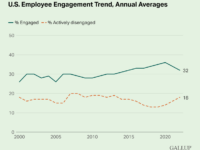With mounting evidence supporting the theory that employee engagement initiatives seriously affect the bottom line, it’s no wonder it “seems to have appeared on every website, every vendor tagline, and in every article I read,” as Josh Bersin notes in his annual Predictions for 2016 report.
The growing chorus and data surrounding engagement illuminates the pronounced, accelerating effect it has on every company’s bottom line and its complexity. But in my experience working with companies throughout the Fortune 1000, engagement’s lowest common denominator is human relationships. They are the fabric of organizations in the knowledge economy. That fact, above all of the others, is what should inform employee engagement initiatives.
Related Interview: One Leader Shares His Approach to Engagement in the Workplace that Sidesteps many Common Stumbling Blocks
Ultimately, these four ideas are crucial in spurring the development of human relationships in your workplace:
1. Alignment
Before you can impact employee engagement, leadership must agree on what engagement is and that it’s a priority worthy of time and money. The effects of a leadership team that’s not fully aligned are severe.
It’s easy to doubt engagement’s importance when questions arise like “Exactly how many more widgets will we make with a 2 percent gain in engagement as opposed to a better machine or process?” They are usually a symptom of an antiquated Industrial Age management mentality.
Engagement-centric leadership is possible everywhere, even in Industrial Age-like fields (consider manufacturing). Take St. Louis-based company Barry-Wehmiller, a global supplier of manufacturing technology and services. The company measures divorce rates among its associates. Why? Because they saw the direct connection between difficulties at work and home and their compounding effects on each other.
2. Measurement
For most organizations, assessing direct impact on employee retention, satisfaction, and productivity is difficult. But that doesn’t mean you shouldn’t try. At Bonfyre, we look beyond overall utilization data and measure sentiment, personas, hot topics of conversation, and the impact of specific campaigns.
For example, one of our customers saw a 67 percent correlation between top sales performers and Bonfyre participation. Obviously, Bonfyre was not the cause, but we learned that the data can be leveraged as a predictive indicator to help illuminate future top performers further upstream. Of course, searching for correlations among data can lead to false positives, but I would challenge leadership to devote resources to “start digging.”
In a similar way, it’s possible to leverage sentiment analysis in environments with high turnover. Doing so helps identify which communities (offices, teams, etc.) have higher volumes of positive or negative comments compared to their peers. The metrics you observe might not be as difficult to define as “sentiment,” but it’s important to decide carefully what you want to measure and how you want to measure it.
3. Credibility
“Buy-in” is not enough; too often it signifies passive endorsement. For organizations seeking to build stronger cultures or increase employee engagement, leadership’s active participation is absolutely critical. Anything less will yield eye rolls and will render employee engagement initiatives inert.
There’s a trickle-down effect from leadership to employee engagement. A manager doing a subpar job will lead to disengaged employees. Therefore, leadership’s proactive participation is a prerequisite to organizationwide credibility around employee engagement initiatives and campaigns. It doesn’t have to be complicated. Executives or managers can participate actively with something as simple as “liking” an employee’s content, posting a photo with their family, or recognizing employees for a job well done.
4. Participation
People love what they help create. In the knowledge economy, leadership must find ways to create a participatory process that gives employees voices. Although every company says their employees are their most important resources, when they ask for feedback and input, it comes in the form of dreaded semi-annual “exams” where employees impersonally answer dozens or hundreds of questions. If employees are your most important resources, shouldn’t you be seeking their input all the time?
Employee feedback loops need to be both on the team level and companywide, in addition to frequent and lightweight—in my opinion, no more than two questions per week. They’re even more effective if they’re planned out well in advance, and most importantly, they should be flexible enough to enable other questions to be sourced from anywhere in the company.
Participation in and of itself is delicate and must be methodically developed by focusing first on building comfort. Comfort will create trust and lead to low-risk ways for employees to contribute. Zappos does it well with, among other things, a scavenger hunt for new hires and “shadow sessions.”
There are so many words written about engagement that it’s hard to know what information is actually valid. But these four factors are proven engagement drivers, and the companies that employ them will reap the rewards.
An edited version of this article was originally published on CEOWorld under the title The 4 Things Every Engagement Initiative Needs to Have.



 4 min
4 min





